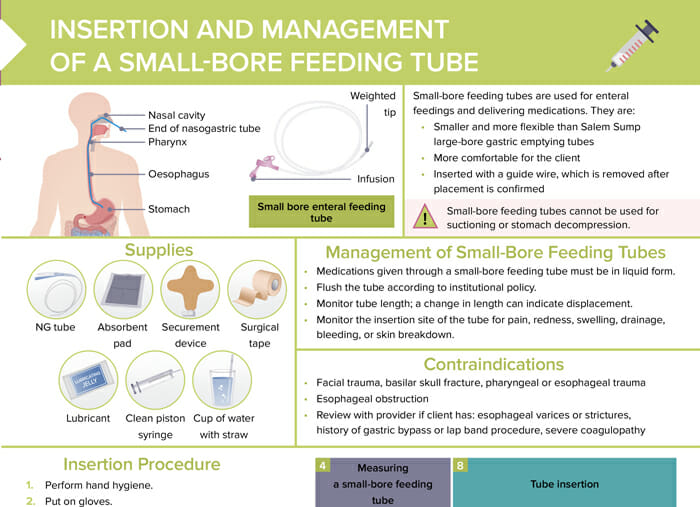What is a small-bore feeding tube?
Small-bore feeding tubes are used for enteral feedings and delivering medications. They are:
- Smaller and more flexible than Salem Sump large-bore gastric emptying tubes
- More comfortable for the client
- Inserted with a guide wire, which is removed after placement is confirmed
Note: Small-bore feeding tubes cannot be used for suctioning or stomach decompression.
How to insert a small-bore feeding tube
Supplies needed
- NG tube
- Absorbent pad
- Securement device
- Surgical tape
- Lubricant
- Clean piston syringe
- Cup of water with straw
Insertion procedure
- Perform hand hygiene.
- Put on gloves.
- Assess client’s nasal cavity, determine which nostril is best for insertion.
- Measure estimated length of the tube.
- Mark measured length with tape.
- Drape an absorbent pad across the client’s chest.
- Lubricate the tip of the tube.
- Insert the tube to the estimated length noted by the tape.
- Temporarily secure tube with tape to the nare.
- Confirm tube placement with X-ray: Small-bore feeding tubes should end in the distal duodenum or jejunum, unlike NGTs, which end in the stomach.
- Remove guidewire after tube placement is confirmed.
- Remove tape and secure the tube with securement device.
- Note the tube’s insertion length.
How to measure a small-bore feeding tube
- Hold the tip of the tube at the tip of the client’s nose.
- Bring the tube to the earlobe.
- Bring the tube halfway between the xiphoid process and the umbilicus.
- Place a piece of surgical tape at this spot to mark the measurement.
Tips for tube insertion
- Have the client position their neck slightly flexed in the sniffing position. You may place your nondominant hand behind their head for stability.
- Insert the distal tip of the small-bore feeding tube into the client’s nostril.
- Have the client tilt their chin to their chest as the tube is advanced.
- As the tube reaches the back of throat, instruct client to sip water, or swallow air, to help advance small-bore feeding tube into esophagus.
- If client begins coughing, or tube coils in the back of the throat, stop the procedure.
- Continue to advance the tube to the predetermined length noted by tape.
Contraindications against small-bore feeding tubes
- Facial trauma, basilar skull fracture, pharyngeal or esophageal trauma
- Esophageal obstruction
- Review with provider if client has: esophageal varices or strictures, history of gastric bypass or lap band procedure, severe coagulopathy
Management of small-bore feeding tubes: enteral feeding considerations
- Medications given through a small-bore feeding tube must be in liquid form.
- Flush the tube according to institutional policy.
- Monitor tube length; a change in length can indicate displacement.
- Monitor the insertion site of the tube for pain, redness, swelling, drainage, bleeding, or skin breakdown.
What is the difference between small-bore feeding tubes and NG tubes?
An NG tube (nasogastric tube) is a type of small-bore feeding tube. The term “small-bore” refers to the tube’s diameter and is used to describe feeding tubes designed for nutritional support.
NG tubes are specifically inserted through the nose and down into the stomach. While all NG tubes are small-bore tubes, not all small-bore tubes are NG tubes. Other types include nasoenteric tubes (going into the small intestine) and gastrostomy tubes (inserted directly into the stomach through the abdominal wall).

